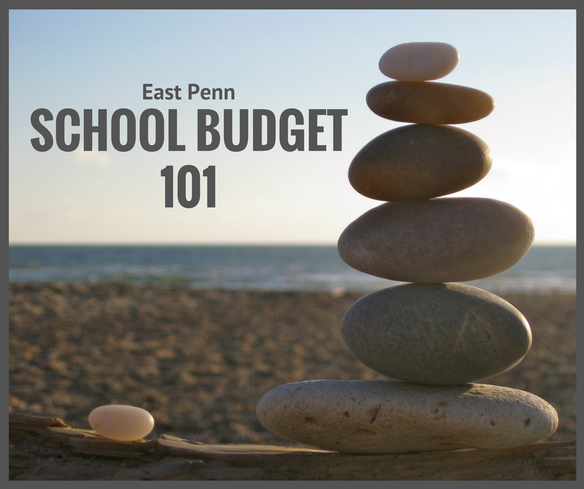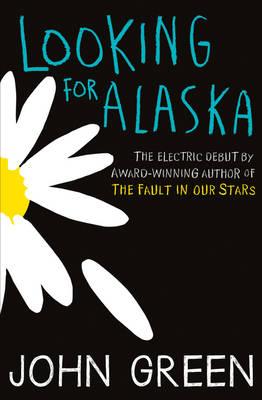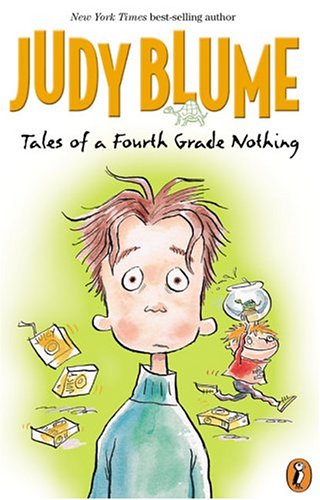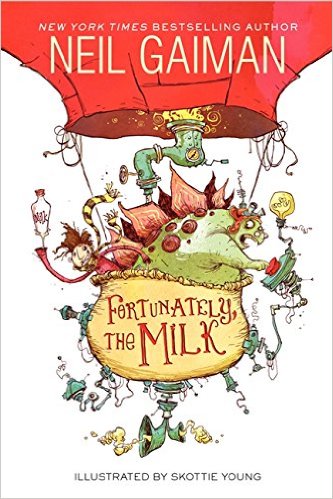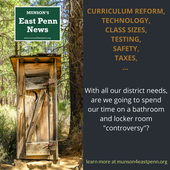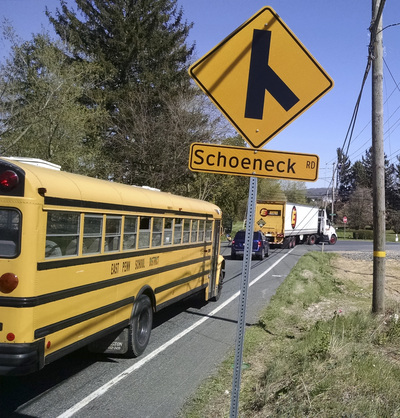
The East Penn School Board will vote soon on whether to offer full day kindergarten to all families in the district. I’m strongly in favor of doing so. I’ve already outlined four key benefits of full day kindergarten. Let me say a few words here about why this is a real need in our community.
Playing Catchup Full day kindergarten is long overdue in East Penn. Thirteen states already require universal full day kindergarten. While Pennsylvania is not such a state, most kindergarteners-- 77%-- are in full day programs anyway. Even in Lehigh County, the majority of districts (5 of 8) offer full day kindergarten to all of their students. Yet we still don’t. Put bluntly, our youngest students are being left behind. Addressing Community Needs We know the need is there. Currently 27% of students in East Penn are not reading proficiently by the end of third grade. Full day kindergarten provides the time and space for gaining the basic foundation needed for later reading skills. We also have increasing poverty and inequality in our community, reflecting larger trends in the country as a whole. Almost 26% of students in the district are now eligible for free or reduced lunch at school, more than double the number just ten years ago. Students from families that are struggling financially often come to kindergarten with fewer life skills, little experience with books, and underdeveloped vocabularies. These needs cannot be met with our current half day programs, which were designed in a different age to serve a community that looks much different than our community today.
Providing Choice
One of the concerns I’ve heard raised about full day kindergarten is that five- and six-year-olds may not be ready to spend six hours at school. Some parents feel strongly that time is better spent at home. I understand both concerns. And I agree that not every child is ready to transition to kindergarten the moment they turn five. Kindergarten is a choice in Pennsylvania - it is not mandatory. Nobody will force parents to send their kids to full day kindergarten if it isn’t right for them. But right now, the majority of parents in our district who would like their kids to enjoy the benefits of a full day program are not able to do so. Establishing full day kindergarten in the district thus opens up more educational choices without taking away any rights of parents to decide what is best for their kids. My support of full day kindergarten is not one I come to lightly; my opinion is based on talking to many people in the district about the issue, researching it on my own, reading what published studies say about the advantages and costs of such programs, and participating in three formal school board presentations and discussions on the issue over the last eighteen months. On the basis of this work, I’ve come to the conclusion that full day kindergarten is right for our district. What do you think? This is one of several posts on the full day kindergarten proposal. You can learn more at:
Want to share a video summary of this post? Here ya go!
0 Comments
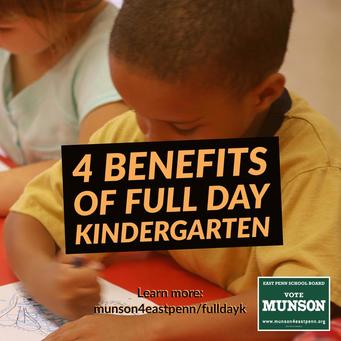
The East Penn School Board will vote soon on whether to offer full day kindergarten to all families in the district. I’m strongly in favor of doing so. Here are four key benefits of full day kindergarten to our community:
1. Improves Readiness for Elementary School (and Beyond) Any good house requires a strong foundation. Even the most expensive, carefully designed home will collapse if it’s built on a cracked or crumbling base. Education is no different. We are spending a great deal of money and effort on improving curriculum and educational programs in the elementary, middle, and high school levels. But these improvements can’t pay dividends if students don’t start with a good school foundation. Full day kindergarten can provide this strong starting point far more effectively than our current half day programs. It increases the odds of students being able to read by the third grade, a key marker of future success in school. Would you be surprised to learn that some children in East Penn come into kindergarten having never even held a pencil or crayon? The time and more personalized attention afforded to full day kindergarten students begins to make up for these kinds of deficits, while also improving the readiness of all our children to be successful learners. 2. Creates Time for Purposive Play In a world of increasing pressure from standardized testing, and ever more specialized standards, it is easy to forget that children need time to absorb new ideas, learn more when lessons are active and playful, and learn most deeply when subjects are integrated and connected to one another. Half day kindergarten simply doesn’t provide enough time for this kind of education. I am impressed with the “living classroom” model for full day kindergarten. Our youngest students learn while they play. Full day kindergarten provides the time needed to incorporate all subjects daily into their activities, and the kids get the time they need to connect different subjects in meaningful ways. 3. Research Shows it Works Evaluating the effects of full day kindergarten programs is more complex than it might seem, because there are so many factors that impact student success. Overall, however, there is a growing body of evidence that full day kindergarten is better for the academic development of students than half day programs, whether measured immediately after kindergarten or measured years later. Such research ranges for case studies of individual school districts all the way to national data that includes information on tens of thousands of different kids (for examples, see here and here). Even in our own community, there is evidence of an immediate payoff from full day programs. The Parkland School District began full day kindergarten last year and already the proportion of their 550 kindergarten students who pass a diagnostic test on early reading skills has jumped from 65% to 80%. 4. Ensures Fairness to all Kids in the District East Penn actually has full day kindergarten already...but only for 2 of its 22 kindergarten classes. The full day programs at Lincoln and Alburtis are highly regarded and sought after by parents. The lucky few students who attend these full day programs go through a hidden admissions process, lotteries, and sometimes long waiting lists. This is unfair to the vast majority of students who could benefit from a full day program. It should be available to everyone in the district. My support of full day kindergarten is not one I come to lightly; my opinion is based on talking to many people in the district about the issue, researching it on my own, reading what published studies say about the advantages and costs of such programs, and participating in three formal school board presentations and discussions on the issue over the last eighteen months. On the basis of this work, I’ve come to the conclusion that full day kindergarten is right for our district. What do you think? This is one of several posts on the full day kindergarten proposal. You can learn more at:
Want to share a short video summary? Here ya go! 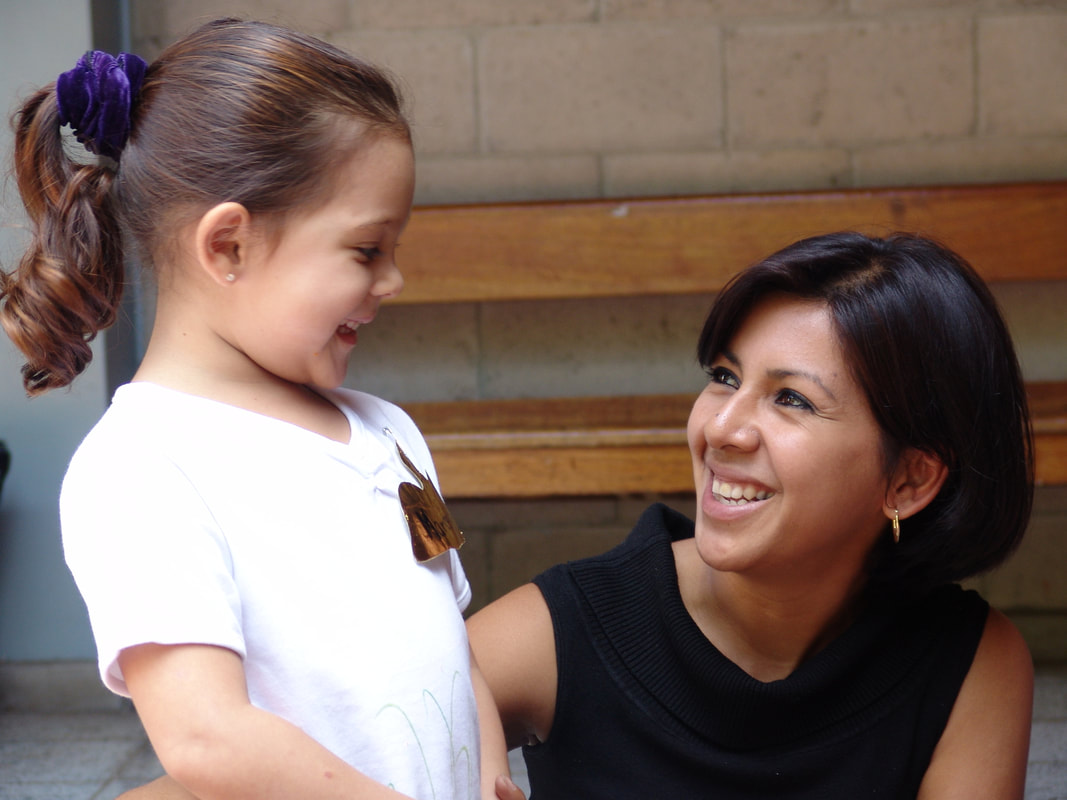 photo courtesy of Heriberto Herrera, freeimages.com photo courtesy of Heriberto Herrera, freeimages.com When is it appropriate for a teacher to touch a student? This was one of the questions discussed at the East Penn School Board meeting earlier this month. It arose because of the adoption of a new district policy governing professional boundaries between adults and students in school (Policy 824). Among many other things, the policy states: "[P]rohibted conduct that violates professional boundaries include, but are not limited to...touching students without a legitimate educational reason. (Reasons could include the need for assistance when injured, a kindergartner having a toileting accident and requiring assistance, appropriate coaching instruction, or appropriate music instruction.)" As a parent, I routinely see teachers touch students. They touch their arm to get their attention, their shoulder to give them comfort, and-- quite often-- they hug students to show they care. When I asked about this kind of teacher-student contact, the superintendent said he felt this kind of touching, including appropriate hugging, fell within the policy because all of it had a “legitimate educational reason.” I agree. I just wish the wording of our policy more directly communicated this interpretation of the importance of touch. I was reminded of this discussion yesterday when I ran across an article on this exact topic. Touching is a tool that allows teachers to connect with students, correct their behavior, help them focus, provide emotional support, and foster trust. As the article concludes: "Society’s well-intentioned attempts to shelter children from the possibility of inappropriate touching have deprived teachers of an important teaching tool and children of an essential sensory, educational, and development experience." I understand the several good motivations for restricting physical contact between students and school staff. And different kids want (and need) different amounts and types of touching. Like any educational technique, no one size fits all. But giving up completely on one of the most powerful tools of communicating, connecting, and working with a child seems foolish. Given how important touch is to the growth of our kids, I hope the teachers and staff in our schools will continue to touch students, educationally. This post too long for you? Tired of reading? Here is the 60-second video version: Nothing in our school district raises more passions, or is shrouded in more confusion, than the annual budget. To help, I’ve put together a five-part series designed to give people a glimpse of the key issues in developing the school district budget each year. My goals are to (1) dispel some of the most common misconceptions about the budget, and (2) explain my own approach to the budget as a school board member. Understanding the budget doesn’t mean that everyone will always agree on the best course of action each year. But at least everyone can understand the main constraints-- and opportunities-- our community faces when it comes to ensuring a quality public education.
Here are the five posts in this series:
After reading this series of articles, please share your own thoughts, concerns, and observations about the East Penn budget process. I welcome your input! PS: You can also check out other posts I've written concerning the budget that aren't part of this series by clicking here. 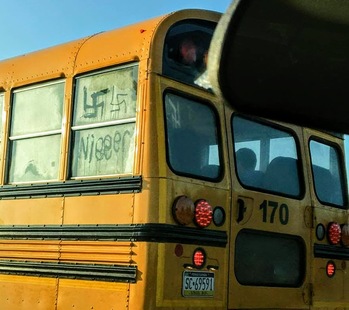 courtesy of Sonia Tapiarz courtesy of Sonia Tapiarz I learned this morning that someone drew two swastikas and the n-word on an East Penn school bus yesterday. A passing motorist took a photograph and alerted authorities. The school district issued a press release this afternoon, saying it "denounces and prohibits this type of racial harassment and is in the process of conducting a full investigation." Our district thus joins others in the area confronting such displays in recent weeks. Southern Lehigh High School has been host to a number of openly racist and homophobic slurs this school year, including students using the Hitler salute. At Saucon Valley, a white student posted a video of a black classmate eating chicken which he narrates using the n-word and series of racist stereotypes. These are a part of a much longer list of incidents that have been reported throughout the Lehigh Valley, both in and outside of schools. Racism and anti-Semitism, of course, are nothing new. Nor is graffiti such as that witnessed on the East Penn bus. But over the last year these kinds of public expressions have become more common. The FBI reports that hate crimes were up 6% last year, with African-Americans and Jews being the most frequent targets. Anti-Muslim hate crimes were up 67%, the greatest increase in fifteen years. Regardless of who drew the graffiti on the school bus window or what their motivations were, incidents like this represent a real danger to our community. Words matter. And these kinds of incidents should not be accepted as normal. The swastika and n-word represent-- very directly-- the anti-Semitism and racism that have characterized some of the darkest moments in our history. I have heard some say that we should ignore these kinds of incidents, either because they are petty, or to avoid giving the perpetrators the attention they seek. I agree with this approach in many cases, but not in this one. Sometimes silence is dangerous. The rise of the Nazi party in Germany in the 1930s was characterized by the appearance of similar (and also seemingly petty) graffiti. The n-word continues to be used today to incite violence against African-Americans, just as it was closely associated with lynching in the past. The need to confront, rather than ignore, this type of incident is particularly important in our district, where minority students represent only a small fraction of the population (4.2% are African-American) and are thus particularly vulnerable to racial and religious intimidation. So how can we use this incident to help our kids and our community do better? I'm no expert here, but I'll tell you what I'm going to do with my own kids: #1 Give them information: We might all be forgiven for wanting to shield our kids from the harsh and brutal truths behind these symbols. But I think kids need more information, not less. Kids lack much of the background and context needed to understand why such symbols are provocative or shocking or dangerous or scary. Simply telling them they are taboo is not enough; giving them knowledge helps both strip the symbols of their power and make sense of a complicated world. I'm going to explain to my kids the historical significance of these symbols, and what kinds of groups use them today. #2 Give them tools: I am going remind my kids that if you see something, say something. This is the phrase used by the Department of Homeland Security to encourage reporting evidence of terrorism. But the same idea applies in the far more common circumstance of witnessing acts of racism, anti-Semitism, or other forms of hate. I will remind my kids that saying something can be hard, because calling out such ugliness can be socially awkward and invite retaliation. But it is precisely the silence that allows a wrong to continue and grow. I’ll highlight for my kids the good example set by Sonia Tapiarz, the woman who reported the East Penn bus incident to authorities. She could have easily just shook her head in disgust and went about her day. But instead she took the time and effort to document what she saw and alert us. As a result of her saying something, positive change can perhaps now come out of the incident. #3 Give them empowerment: I am going to ask my kids about their opinion of the graffiti incident. I'm going to encourage them to ask lots of questions, and help them them find answers on their own. I want them to know that they should not stand by passively as events in their community unfold. I want them to a part of those events, bringing their own values, perspectives, knowledge and skills to the table. #4 Give them examples: I am going to tell them about the steps I am taking in response to this issue. Step one is sharing this post with the larger community. Step two is writing the East Penn Superintendent, Dr. Mike Schilder, directly. I am going to share with him my belief that students in our district will learn important lessons from how he leads the district in its response to this incident. I am going to remind him of his responsibility as the most visible educational leader in our community. And I'm going to ask him to use his expertise as both an educator and leader to teach our students about what swastikas and the n-word represent, how they can be dangerous, why incidents like this are happening now, and what concrete steps the district is taking to confront them. #5 Give them resources: I am going to ask my kids to find a community organization devoted to addressing the issues of racism and anti-Semitism to which we can make a donation of our time or money. They will see how our family can work with others to make such incidents less likely in the future. I want my kids to gain experience advocating for some of the core values that serve as the bedrock of our community-- chief among them the fundamental humanity and dignity of us all. We should not put our heads in the sand when it comes to issues like this, or dismiss the significant concerns they raise as just “political correctness.” As the conservative philosopher Edmund Burke famously said, "the only thing necessary for the triumph of evil is for good men to do nothing." I would add that evil doesn’t come all at once; it sneaks up on us, little by little, with many of those involved not even aware they are caught up in it.
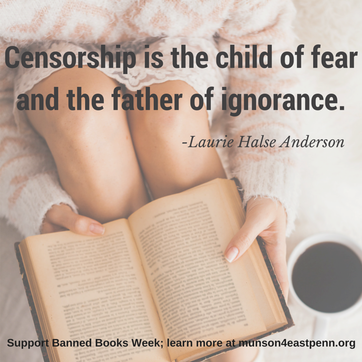
The most frequent target of censorship attempts in 2015 was John Green’s Looking for Alaska. The year before it was another young adult novel, Sherman Alexie’s The Absolutely True Diary of a Part-Time Indian.
Censoring books, whether in the form of keeping them off library shelves, off reading lists, or outright bans, does not help us maintain our values or protect our children. Quite the opposite. Freedom of expression-- and the free exchange of ideas-- are at the foundation of our community’s strength. Young adult author Laurie Halse Anderson puts it this way: “Censorship is the child of fear and the father of ignorance.” Like most people, there are many books whose content I find appalling; books I hope my children never read. But those books should be protected too. That is the very meaning of free speech. As the prolific Neil Gaimon has said, “The same laws cover the stuff you like and the stuff you find icky, wherever your icky line happens to be: the law is a big blunt instrument that makes no fine distinctions...you only realise how wonderful absolute freedom of speech is the day you lose it.” “It’s not just the books under fire now that worry me,” says Judy Blume (you know, of Super Fudge fame), “it is the books that will never be written, the books that will never be read. And all due to the fear of censorship. As always, young readers will be the real losers.” I’ve written about the censorship issue in our own community before. I’m sharing these thoughts and quotes from famous children’s book authors today in support of the American Library Association’s “Banned Books Week,” which raises awareness of the continued problem of censorship in our bookstores, libraries and schools. You can find the top 10 list of most frequently challenged books in 2015, as well as lots of other information, at their website. So please, the next time you discover a book that is offensive, overly sexual, sacrilegious, racist, or otherwise objectionable-- don’t call for banning it. Trying to hide such ideas never works. Instead, just return it to the shelf and help your kid-- or yourself-- find something better. Here is John Green’s response to having written the most challenged book of last year. He is far more articulate than I in making the case that banning books just doesn't make sense-- a great 3 minutes:
Previous posts on the issue of book censorship:

My post on the trumped up transgender bathroom controversy at Emmaus High School got a bigger response than anything I’ve ever put on this blog. If you're like me, you probably didn’t grow up around many people who were openly transgender and very well might not have friends or family who publicly identify as trans. One of the chief sources of uncertainty, fear, and controversy around transgender students in our school district stems from this lack of knowledge and familiarity. Here are the most helpful things others have sent me to help overcome such uncertainty and fear...
A short but moving description from a mother of a trans girl who makes clear that the issue is about the dignity and worth of our children, not political correctness:
A father-- Republican, National Rifle Association member, and military veteran-- discussing the difference between his twins, one of whom is trans:
An explanation by a trans girl helped me walk a few minutes in her shoes:
A more local perspective is provided by a recent feature story by the Morning Call, which profiles the journey of two Lehigh Valley trans students and offers some helpful definitions of different terms used in discussion of sexual identity.
One doesn’t have to agree with everything the speakers in these videos and article say to agree with the hope that all our children have the right to claim their own authentic identity and not have one forced on them by outside social norms or peer pressure. Okay, I’ll fess up and say that I don’t know if there are seven things to be learned here, or twenty things, or three. But if you’re like me, you certainly learned something. Related posts: 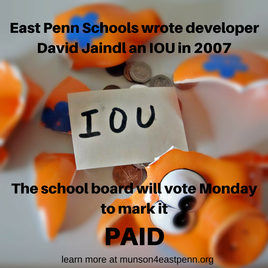
The East Penn School District will vote Monday on an important agreement with real estate developer David Jaindl over the future of land once known as the Romig farm in Lower Macungie Township. Overall I think it is the best among bad options for the district, and I tentatively plan to vote in favor of the agreement. You can read the agreement yourself here (Exhibit #8). In order to help community members understand what is happening, I’ve put together the following list of Frequently Asked Questions (FAQ):
Why does the district need to make this agreement?
The short answer is that it is required to do so under a previous contract that was signed in 2007. The longer answer is that the 2007 contract was a kind of IOU the district gave to Jaindl. The deal put the district on the hook for a number of expensive things, including giving Jaindl 14 acres of land along Route 100, paying the cost of a new road for him, and providing him with the right to purchase additional property at a fixed rate if the district ever sells it. The new agreement to be voted on Monday represents the district settling that IOU.
What are the main elements of the deal?
The district will follow through on its existing legal obligation to give Jaindl 14 acres of land along Route 100, between Sauerkraut and Shoeneck roads. In addition, it will pay Jaindl $1.7 million to settle other terms of the original 2007 agreement, which he may only use for improvements to Sauerkraut Road. The district will also allow additional land-- approximately 8 acres-- to be used for storm water basins to handle runoff from a new Sauerkraut Road extension and redesigned Shoeneck Road intersection. In exchange, the district will have no other obligations to Jaindl or Lower Macungie Township, and Jaindl surrenders his current right to buy remaining parts of the Romig farm property at a below-market price in the future. The district retains ownership of approximately 80 acres in the area for future use, if needed.
What will it cost taxpayers?
The $1.7 million owed to Jaindl will be paid for using funds from its capital reserve, bolstered by proceeds from two recent sales of much smaller properties along Lower Macungie Road. The agreement should therefore have no direct effect on local property taxes or next year’s school district budget. More indirectly, the district will lose 22+ acres of land on this property. But this loss was already built into the 2007 contract that this new agreement replaces. That is, it was part of the IOU the district has owed Jaindl for almost a decade now; it doesn’t represent a new loss to the district or the public.
What does the community get out of the deal?
First and foremost, the community gets to lay to rest the contractual obligations the district has owed Jaindl since 2007. The $1.7 million payment is substantially lower than the district would likely have to pay to build the road required in the 2007 contract, a cost that would only rise in the future. Jaindl gives up future rights to the remaining property as well, making it possible for the district, and thus the community, to get the full value of the land if any more is sold in future years. This agreement also allows much-needed safety improvements to the intersection of Route 100 and Shoeneck Road, which has been the source of significant concerns over the last several years.
What is the history behind this piece of property?
The story of the most recent agreement can be traced back more than a quarter century, when the school district used its power of eminent domain in 1989 to purchase a 108-acre farm along Route 100 owned by the Romig family. The district planned to build a second high school on the property. Instead, the Romigs sued the district, and the resulting public outcry led a reconfigured school board to hastily reverse its decision and return the property to the Romigs-- at substantial cost. Fast forward to 2007. Seventeen years after the first controversy with the Romig farm, the district still faced uncontrolled growth of residential development on former farmland in Lower Macungie Township. Developers were building new housing much faster than the district could accommodate the influx of new students, with no end in sight. The school board was desperate to purchase property in the area large enough to handle several new schools they anticipated would soon be needed. It is in this context that they signed the 2007 contract with Jaindl that gave them ownership over the Romig farm. Jaindl served as a middleman between the school district and the Romig family. In negotiating this new agreement with Jaindl over the last two years, the current school board has insisted that all of the different issues surrounding the property be resolved in a single deal in order to avoid the ‘divide and conquer’ strategy that real estate developers, including Jaindl, have used in the past to work out the best deals for themselves. Doing so gave the district much more leverage in negotiations than they might have had otherwise.
What is the bottom line here?
All of this boils down to a basic question: Is the school district better off under the original 2007 contract with Mr. Jaindl or this new agreement? I currently believe the new agreement is the better one. I describe the deal as “the best of bad options” because I’m saddened to see the further destruction of beautiful farmland in Lower Macungie Township, and I would strongly prefer to use the $1.7 million to improve education rather than roads. At the same time, the original 2007 contract already requires the loss of the same farmland, would cost the district even more money, and allow Jaindl to have continued influence over the remainder of the property. This new agreement thus represents a substantial improvement for our district and our community. I therefore plan to vote in favor of this new agreement unless substantially new information comes to light at the meeting Monday night.  photo credit: stash via photopin (license) photo credit: stash via photopin (license) The U.S. Congress has a longstanding law prohibiting American politicians from taking campaign contributions from foreign governments and citizens. The law was affirmed unanimously by the Supreme Court as recently as 2012, and for good reason: Outside powers should not be able to choose our political leaders, or control them once they’re in office. I believe this same logic applies to our own local community as well. Local control of our schools depends on local control over our school board elections. If we don’t trust national leaders to pursue the common good while taking outside money, why should we trust local leaders to pursue our community’s best interests while taking outside money? Unfortunately, this is an issue we all face in the upcoming East Penn School Board elections next month. According to campaign finance reports, two candidates-- Chris Donatelli and Carol Allen-- have solicited some of their most significant campaign contributions from outside donors (their campaign finance reports are available here). Let me be clear: it is not illegal for a school board candidate to take money from outside the district. They are well within their rights to use these campaign dollars to influence the East Penn School Board race in any way they wish. But outside money in a non-partisan, community election is invariably targeted at scoring partisan political points that make up the ongoing dysfunction of Washington DC and Harrisburg, not the good of our community. Even more importantly, using outside money in a school board election is inconsistent with the principle of local control of schools, a principle that both Mr. Donatelli and Ms. Allen have repeatedly said is at the core of their campaign. I agree with Mr. Donatelli and Ms. Allen that local control is a principle worth defending. I therefore call on them to return the money they have received from outside our community, particularly the money received from outside politicians. Let’s let the people of East Penn decide who will best represent them on the school board, not outside funders. Following the money can’t tell you everything about a candidate. But it certainly can tell you something! I urge Ms. Allen and Mr. Donatelli to join the other five candidates in the local school board race-- Wally Vinovskis, Rich Mathesz, Paul Champagne, Ken Bacher and Chuck Ballard-- in refusing to take money from outside the district.  photo credit: sensitive noise / obvious 2 via photopin (license) photo credit: sensitive noise / obvious 2 via photopin (license) As you may or may not be aware, the East Penn School district is selling the former Lower Macungie Elementary School property that is at the corner of Krocks and Lower Macungie Road. The vote was 8-0 in favor of the sale at the August 10th, 2015 board meeting. You can read the Agreement of Sale for yourself if interested (look for Exhibit #16). Incidentally, the board also discussed a policy for allowing service horses inside district buildings at that same meeting-- see what you are missing by not attending?! Last night I received an email from a fellow community member asking about the reasons for the sale and expressing concerns about the sale price. I am posting my (slightly edited) response here, as it might be of interest to others: I can't speak for the board as a whole, but I will tell you briefly why I voted for the sale. My first choice would have been to preserve Lower Macungie Elementary for possible re-opening as a school if it were needed down the road. Unfortunately, however, the school building is no longer usable by the district because the cost of making wheelchair access and other required code improvements to the building are cost prohibitive. There is no reasonable way to bring it up to code without incurring huge capital expenses that are unwarranted by the size and current condition of the building. Indeed, even maintaining the building right now is expensive-- the rent from the current tenant barely covers the district's maintenance costs. And, of course, keeping the property without using it to educate our students means the property is not on the tax rolls, putting that much more pressure on existing taxpayers in the community. Another possibility, of course, would have been to keep the property for possibly building a brand new school in the future. Unfortunately, that particular piece of land is not big enough to accommodate a modern school-- again, because of changes in the legal requirements the district has to meet for new construction. Why sell now is another reasonable question. As you may know, the district is going through a period of enormous financial strain. I would like to keep taxes as low as possible without having to cut programs like music, arts, and athletics, as they have done in places like Allentown. And I don't want to cut teachers-- we already have class sizes in many schools that are far too high. Because this is a piece of property that the district is not using, and cannot reasonably expect to use for a school in the future, it doesn't strike me as fiscally responsible to hold on to it while at the same time asking taxpayers to continue to foot higher bills to meet the current financial strain. In terms of the price, I disagree with those that have suggested the sale price is too low. The district commissioned multiple assessments of the property's value and had a professional valuation conducted. As a final check on this work, a court must certify that the district received fair market value for the property before the deal is finalized. I used all of this data in making my judgment that the $840,000 price was a good deal for the district. I don't know if this explanation will convince everyone that the sale was the right thing to do, but I hope that it at least makes it clear what reasons I had for voting for the sale. I take my responsibility as a steward of district resources extremely seriously. District resources are, after all, ultimately the community's resources. My vote in favor of the sale was not made lightly and came after a great deal of study of different options. My daughter attended kindergarten at Lower Macungie Elementary, and I will miss the school that has been standing in that spot for over 60 years. But in the end, I had to consider all possibilities, and in this case I believe the sale was the best option for our district and our community. |
Details
Categories
All
Archives
December 2017
|
